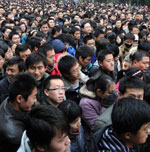City Mayors: Urban population growth (original) (raw)

China's urban population stands at more than 600 million
FRONT PAGE
Site Search
About us

Urban population growth from now to 2030
World's largest cities and their mayors 2011
World's largest cities 2007
Capital cities
Largest cities in the world
Largest urban areas
Largest European cities
Largest US cities
Largest Canadian cities
Largest Brazilian cities
Largest German cities
Largest French cities
Largest French urban areas
Largest UK cities
Largest Italian cities
Largest Spanish cities
Largest Indian cities
Largest Japanese cities
EIU: Best cities in the world
Mercer: Best cities in the world
Most expensive cities in the world
Richest cities in the world
Urbanisation 2008 to 2030
Worldwide | Elections | North America | Latin America | Europe | Asia | Africa |


























Urban population growth
between 1950 and 2030Research by Alidad Vassigh and Tann vom Hove
7 August 2012: In 2008, the world reached an invisible but momentous milestone: For the first time in history, more than half its human population, 3.3 billion people, lived in urban areas. By 2030, this is expected to swell to more than five billion. Many of the new urbanites will be poor. Their future, the future of cities in developing countries, the future of humanity itself, all depend very much on decisions made now in preparation for this growth.2017: LARGEST CITIES IN THE WORLD AND THEIR MAYORS
• Table 1: Urbanisation in selected countries between 1950 and 2030
• Table 2: Urban population in 122 countries together with their largest cities
• Table 3: Countries with the largest number of people living in urban areas
• Table 4: Countries with the highest proportion of people living in urban areasIn its 2011 report on global urbanisation, the UN wrote that between 2011 and 2050, the world population was expected to increase by 2.3 billion, passing from 7.0 billion to 9.3 billion. At the same time, the population living in urban areas is projected to gain 2.6 billion, passing from 3.6 billion in 2011 to 6.3 billion 2050. Thus, the urban areas of the world are expected to absorb all the population growth expected over the next four decades while at the same time drawing in some of the rural population. Most of the population growth expected in urban areas will be concentrated in the cities and towns of the less developed regions. Asia, in particular, is projected to see its urban population increase by 1.4 billion, Africa by 0.9 billion, and Latin America and the Caribbean by 0.2 billion. David Satterthwaite from the International Institute for Environment and Development (iied) already said in 2007 that population growth was becoming largely an urban phenomenon concentrated in the developing world.
Urbanisation has already surpassed the 90-per-cent mark, not only in city states like Singapore and Kuwait, but also in Belgium, Venezuela, Uruguay, Argentina, Israel and the UK. In the US, where for the past 100 years the majority of people have been living in cities, more than 82 per cent of the total population now reside in urban areas. Other countries where the urban population stands at above 80 per cent include Australia, Chile, Brazil, Sweden and South Korea.
The urban population of China accounts for close to 45 per cent of the country’s total number of people, while in India the corresponding figure is just over 30 per cent. With only eleven per cent of its citizens living in towns, Burundi is the least urbanised country in the world.
Between now and 2030, the percentage of people living in urban areas will increase strongly in countries like Morocco, from 57 to 73 per cent; Indonesia, from 54 to 69 per cent; Nigeria, from 50 to 66 per cent; Bosnia, from 49 to 62 per cent; China, from 45 to 60 per cent; Sierra Leone, from 38 to 60 per cent; Pakistan from 37 to 50 per cent; Vietnam, from 29 to 42 per cent; Bangladesh, from 28 to 40 per cent and India, from 30 to 41 per cent.
Countries where more than 100 million people already live in urban areas include China (601 million), India (352 million), the USA (254 million), Brazil (169 million), Indonesia (129 million) and Russia (103 million).
Urbanisation in selected countries between 1950 and 2030
| Country | 1950Urban population as percentage of total | 2010 Urban population as percentage of total | 2030Urban population as percentage of total (Estimate) |
|---|---|---|---|
| Argentina | 65.3 | 92.4 | 93.2 |
| Australia | 77.0 | 89.1 | 91.9 |
| Bangladesh | 4.2 | 28.1 | 39.9 |
| Brazil | 36.2 | 86.5 | 91.1 |
| Canada | 60.9 | 80.6 | 84.4 |
| Chile | 58.4 | 89.0 | 92.3 |
| China | 13.0 | 44.9 | 60.3 |
| Egypt | 31.9 | 42.8 | 53.9 |
| Ethiopia | 4.6 | 17.6 | 27.1 |
| Finland | 31.9 | 63.9 | 68.9 |
| France | 55.2 | 77.8 | 82.9 |
| Germany | 64.7 | 73.8 | 80.0 |
| India | 17.0 | 30.1 | 40.7 |
| Indonesia | 12.4 | 53.7 | 68.9 |
| Iran | 27.5 | 69.5 | 77.9 |
| Israel | 71.0 | 91.7 | 93.0 |
| Italy | 54.1 | 68.4 | 74.6 |
| Kenya | 5.6 | 22.2 | 33.0 |
| South Korea | 21.4 | 81.9 | 86.3 |
| Malaysia | 20.4 | 72.2 | 81.9 |
| Mexico | 42.7 | 77.8 | 82.8 |
| Netherlands | 56.1 | 82.9 | 88.6 |
| Nigeria | 11.6 | 49.8 | 66.0 |
| Pakistan | 17.5 | 37.0 | 49.8 |
| Philippines | 27.1 | 66.4 | 76.7 |
| Poland | 38.3 | 61.2 | 70.0 |
| Portugal | 31.2 | 60.7 | 71.4 |
| Russia | 44.2 | 72.8 | 75.7 |
| Saudi Arabia | 21.3 | 83.6 | 86.2 |
| South Africa | 42.2 | 61.7 | 71.3 |
| Sweden | 65.7 | 84.7 | 83.1 |
| Switzerland | 44.3 | 73.6 | 83.1 |
| Syria | 30.6 | 54.9 | 61.0 |
| Thailand | 16.5 | 34.0 | 45.8 |
| Turkey | 24.8 | 69.6 | 77.7 |
| UK | 79.0 | 90.1 | 92.2 |
| USA | 64.2 | 82.3 | 87.0 |
| Venezuela | 46.8 | 94.0 | 97.1 |
| Vietnam | 11.6 | 28.8 | 42.8 |
Source: World Bank
Table 2: Urban population in 122 countries together with their largest cities
Table 3: Countries with the largest number of people living in urban areas
Table 4: Countries with the highest proportion of people living in urban areas



